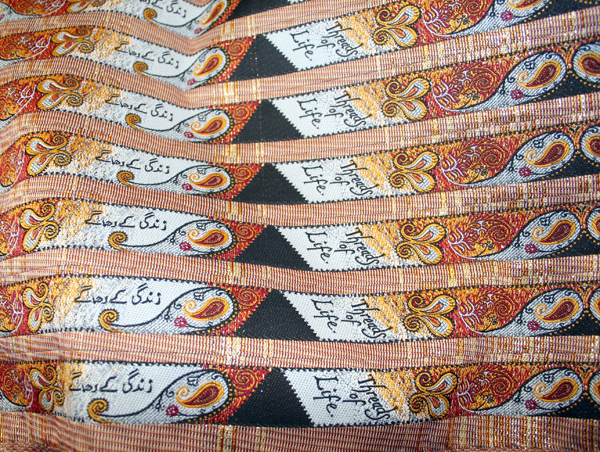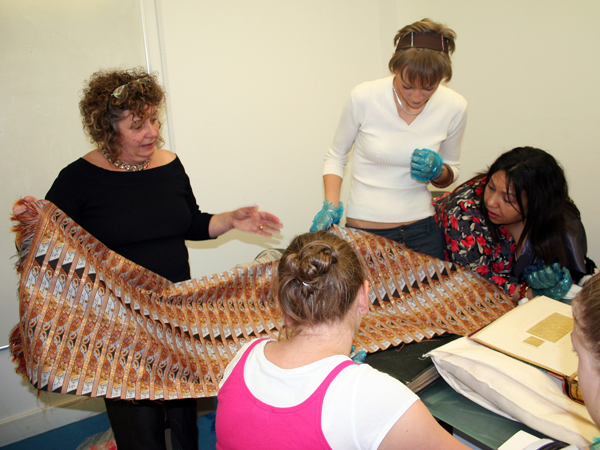 In October 2006, when the Textile Archive was in storage before relocation to its current home in the Old Building, we received a visit from Ruth Caswell, the award-winning costume designer/maker. She had been inspired by fabrics in our ‘Indian collection’ to create the Threads of Life ribbons which were produced to commemorate and raise funds for the Lord Mayor’s Bradford Kashmir Earthquake Trust as a testament in textiles and a mission of remembrance. As well as unveiling the woven fabric on her visit, Ruth led a series of workshops for Bradford College fashion students, disclosing the design and manufacturing process, before involving them in finishing some of the ribbons ready for sale.
In October 2006, when the Textile Archive was in storage before relocation to its current home in the Old Building, we received a visit from Ruth Caswell, the award-winning costume designer/maker. She had been inspired by fabrics in our ‘Indian collection’ to create the Threads of Life ribbons which were produced to commemorate and raise funds for the Lord Mayor’s Bradford Kashmir Earthquake Trust as a testament in textiles and a mission of remembrance. As well as unveiling the woven fabric on her visit, Ruth led a series of workshops for Bradford College fashion students, disclosing the design and manufacturing process, before involving them in finishing some of the ribbons ready for sale.
Ruth explained: “I was deeply moved by the news coverage of the earthquake while conscious that after the initial focus, media attention and people’s consciousness moves on to the next disaster, although for the victims moving on when everything they had has been lost, is not so easy. From my years of working in fashion and design I was convinced that culture and design encapsulate what people are really about and I wanted to do something so that peo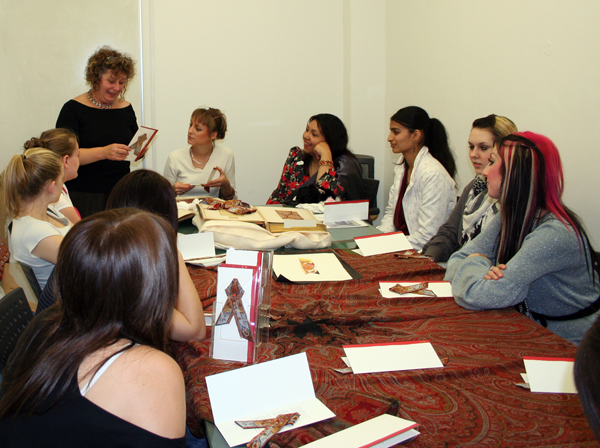 ple would remember. Fundraising was an important, but equal, consideration. A crucial intention behind the ribbon was to create a memorial to them in textiles. I wanted the ribbon to have a little fringe so that each one was like a mini Kashmir shawl. My daughter Amy, a professional designer, worked on the design with the utmost care as with Islamic textiles the design is a prayer."
ple would remember. Fundraising was an important, but equal, consideration. A crucial intention behind the ribbon was to create a memorial to them in textiles. I wanted the ribbon to have a little fringe so that each one was like a mini Kashmir shawl. My daughter Amy, a professional designer, worked on the design with the utmost care as with Islamic textiles the design is a prayer."
Ruth’s inspiration for the ribbon stemmed from when she lectured in fashion and textiles at Bradford College between 1986 and 1997, in the days before the Textile Archive was opened. She recalled, “I was very lucky to train in fashion during the 1960s which was such an exciting time when you really could knock something up in your bedroom and sell it on the King’s Road. I enjoyed success and had designs featured in Vogue and then taught here for a while. I found it such an inspiring place to work as I kept finding incredible books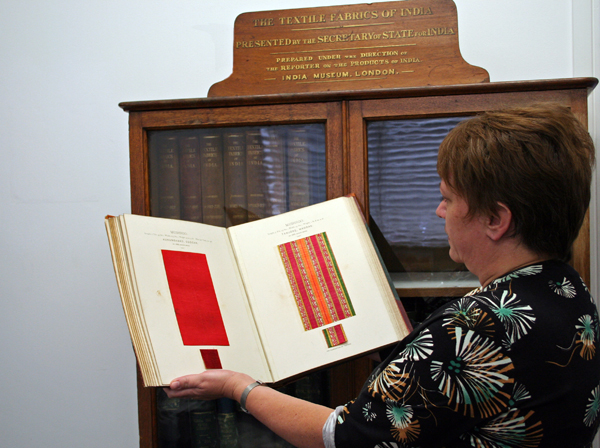 , for instance stunning 1920s fashion industry samples. But the very best thing for me was a cabinet of books, the Textile Manufactures of India, presented to the College by the Secretary of state for India in the 1870s. The samples in these volumes have retained their beauty and luxuriant feel for over 130 years, and to preserve them we must wear gloves to handle the volumes. The Boteh paisley design is one that everyone knows and if you look at it closely you can see that it is based on a seed, a new life foetus, a symbol of rebirth.”
, for instance stunning 1920s fashion industry samples. But the very best thing for me was a cabinet of books, the Textile Manufactures of India, presented to the College by the Secretary of state for India in the 1870s. The samples in these volumes have retained their beauty and luxuriant feel for over 130 years, and to preserve them we must wear gloves to handle the volumes. The Boteh paisley design is one that everyone knows and if you look at it closely you can see that it is based on a seed, a new life foetus, a symbol of rebirth.”
Ruth continued, "I knew that we could still weave Jacquard locally as a firm in Keighley specialised in very intricate labels for the designer garments that had overtaken the fashion industry in the 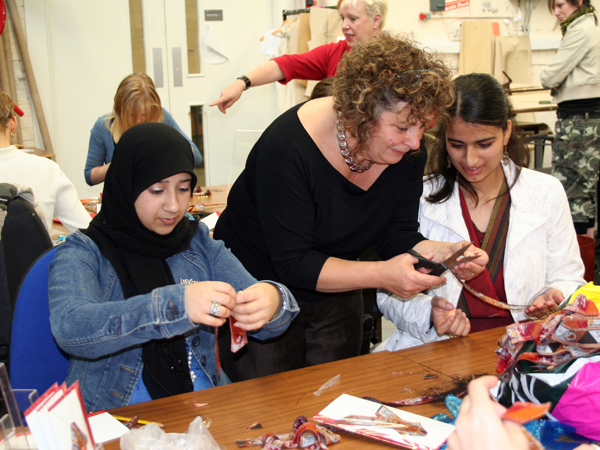 90s. They had a really good team of young women designers capable of the fine attention to detail required. Everyone involved in the project was fired with enthusiasm and worked for free. Then Bradford launched an earthquake appeal and I realised that this could become their poppy – a tribute showing what we owe the Kashmiri people in terms of fashion and design. The Lord Mayor has adopted this as his official gift for the year, rather than giving important visitors a commemorative paperweight, or whatever.”
90s. They had a really good team of young women designers capable of the fine attention to detail required. Everyone involved in the project was fired with enthusiasm and worked for free. Then Bradford launched an earthquake appeal and I realised that this could become their poppy – a tribute showing what we owe the Kashmiri people in terms of fashion and design. The Lord Mayor has adopted this as his official gift for the year, rather than giving important visitors a commemorative paperweight, or whatever.”
She added, “We wanted to make the ribbons look precious, so Amy added gold thread to the design to give it that exoticism and magic that comes from this tradition. We included a gold bejewelled pin and paid great attention to how they would be packaged and displayed. We had to make it work at the point of sale so we got involved in printing the cards and sourcing Perspex stands. This is an important lesson for all fashion students – never compromise on design at any stage in the process. We have also produced ties, which is important so we can get all those ‘suits’ wearing them, and a small number of pashminas too. All the work has been done by women. This was not intentional but I don’t think that men would 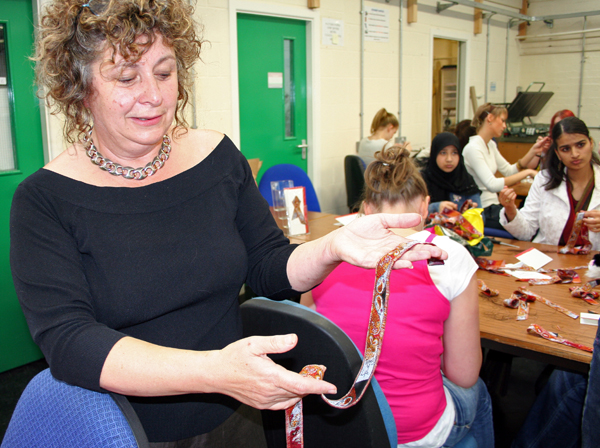 have fiddled with it to the extent we have – though we have had tremendous support from men. It is the first anniversary of the earthquake this weekend and it is moving to be here at Bradford College, speaking to fashion students, to show how such a beautiful resource can be used to create a worthwhile response to tragedy. Everyone in Bradford shares a textile legacy - it was textiles that brought the Irish, Italians, Ukrainians, Germans, French and many other others as well as the Kashmiri people to this city. This initiative is not political, not religious - our agenda is textile fashion.”
have fiddled with it to the extent we have – though we have had tremendous support from men. It is the first anniversary of the earthquake this weekend and it is moving to be here at Bradford College, speaking to fashion students, to show how such a beautiful resource can be used to create a worthwhile response to tragedy. Everyone in Bradford shares a textile legacy - it was textiles that brought the Irish, Italians, Ukrainians, Germans, French and many other others as well as the Kashmiri people to this city. This initiative is not political, not religious - our agenda is textile fashion.”
The response to the designs was phenomenal. The limited edition ribbons and ties were sold at Salts Mill, the Aagrah group of restaurants plus museums and galleries, including the College’s Yorkshire Craft Centre, raising valuable funds and awareness.
